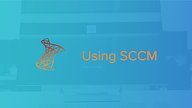Microsoft SCCM and the alternatives in 2019

First released in 1994, Microsoft SCCM is now ubiquitous across many organizations. And that's especially the case for Higher Education institutions such as universities and colleges.
Formerly known as Systems Management Server (SMS), SCCM is widely used by our customer base and by many more IT departments worldwide. But what is SCCM? What does SCCM do? And are there any alternatives to SCCM in 2019? In this article, we take a look at everything to do with the technology, including its key use cases, benefits and limitations.
What is SCCM?
Microsoft SCCM, also known as Microsoft System Center Configuration Manager or just ConfigMgr, is one of the most popular computer endpoint management systems used by today. It comes with a broad range of features and benefits, but ultimately its mission is to help make the creation, distribution, and management of computer images and software easier for IT administrators.
As a technology, there's a long list of functionality that comes with SCCM, and as such, it can be used for a variety of common IT tasks. Typically it is used to manage large amounts of Windows devices, including the deployment of operating systems, software and patches through remote access/control.
The most popular functions of SCCM within a Higher Ed setting include:
- Creating computer images
- Mass deploying images
- Distributing silent installs of software applications
- Managing software across campus
- Inventorying organization-owned hardware and devices
How does SCCM work?
SCCM works through a couple of key pieces of technology: PXE (Pre-Boot Execution Environment) Booting, the SCCM Agent, and Task Sequences.
PXE Booting enables a raw or unconfigured computer to boot against the SCCM environment in order to receive its instructions for imaging. Without this, a technician would have to manually boot from other media, such as the default OS, CD, or USB drive to start the configuration process. By booting over the network, all computers being imaged can stay physically in place and imaging can be completed from the central IT office. To learn more about how to begin PXE booting as part of your imaging process, check out How-To-Geek's detailed & informative guide, 'What Is Network Booting (PXE) and How Can You Use It?'
The SCCM Agent is what gives the SCCM console its data feed. Once the agent is active a computer, IT technicians and admins can inventory the hardware and software, distribute software, initiate remote admin tasks such as reboots and remote control, and more. Without the agent running, there is no central management of the computer estate.
Task Sequences enable automation of an almost unlimited set of tasks. From applying license keys to performing Active Directory joins, to software deployment, and more, Task Sequences give IT admins a wealth of power to fully automate deployment and management of their on-campus computers.

Microsoft SCCM

Symantec/Norton Ghost

Citrix

VMware

Cloudpaging

Parallels RAS

Why is it such a popular technology?
One of the most popular reasons that SCCM is used, especially in Higher Ed, is because of the cost. In 2012, Microsoft started including the SCCM licensing at no additional charge with most campus agreements. That essentially delivered all of the functionality and benefits of SCCM to IT for free, with no ongoing ownership or licensing costs (outside that of the university's campus agreement with Microsoft).
It's also ever-popular because it provides a way for university IT to distribute and deploy Windows software applications to devices across campus. Through its imaging capabilities, SCCM enables IT to make software available in certain computer labs on certain devices, without the need for manual installs on a per-machine basis.
That particular functionality is only otherwise available - traditionally, at least - by taking advantage of some form of VDI or Desktop Virtualization technology, which involves a major cost uplift against using SCCM in isolation; even if the process of creating and distributing images comes with its own set of limitations!
SCCM and Active Directory
As with most Microsoft products, SCCM leans quite heavily on Active Directory to get full functionality. While you can manage non-domain-joined machines via the SCCM Agent, you will lose quite a bit of the automation and mass update functionality that relies so heavily on Active Directory.
What are the costs of SCCM?
While for universities and colleges SCCM may be free from a licensing perspective, it does take a fair amount of skill, knowledge and time to utilize effectively. However, the online SCCM community is incredibly robust and active and filled with senior admins open and willing to provide answers when they arise.
Unlike many traditional virtualization technologies (e.g. VDI), which are often considered necessary to augment the software deployment part of SCCM and the delivery of Windows applications to non-Windows devices, SCCM does not rely on a server farm or heavyweight backend infrastructure. That said, to deliver heavyweight applications through imaging requires the endpoints themselves to be capable of running those applications, in order to provide an end-user computing experience that the students expect.
For other types of organizations, SCCM is a chargeable product from Microsoft and will require a paid license following your trial period.
What are the benefits of SCCM?
The benefits of SCCM are many, but typically the most important of these is the automation of computer imaging. By leveraging the technologies of PXE Booting, driver injection and Task Sequences, a fully automated deployment of a new image across all campus computers can be achieved. As with any automated system, having a good inventory of your estate (models, hardware specs, locations, etc.) is critical, and you may not reach 100% success on the first go, but SCCM puts you in a great position to get there.
In addition, SCCM provides some clear efficiency and time-saving wins when compared to having to manually image every device across campus from a CD or USB. By centrally creating, managing and deploying images, there's also a greater level of consistency when it comes to the user experience of your endpoints.
The final benefit of Microsoft SCCM is for sure the cost. In our experience, many universities on a global level all start in some way with SCCM for delivering their software apps to managed devices across campus. Along with virtualizing a few applications with App-V - which has a close integration with SCCM - this approach is very often the first port of call when it comes to application deployment, entirely due to the cost.
However, the more advanced the university IT department becomes and the more it focuses on how innovative technology solutions can be used to improve the student experience, the more IT departments look to next-generation technologies to provide the answer instead.
What are the limitations and disadvantages of SCCM
Whilst other imaging solutions may carry some rudimentary methods of imaging non-Windows devices, SCCM does not. Even the solutions with this capability tend to rely on principles or integrations from other technologies to achieve true cross-platform delivery.
Due to the nature of imaging, it tends to be inflexible and demanding. An image 'pre-loads' managed machines with selected software estates. The initial implication of this is that every piece of software on a given machine must be included in the image and, once the machine is imaged those pieces of software reside there permanently. For any changes to be made the entire image must be rebuilt; a task too time-consuming and laborious to be feasible mid-semester. Furthermore, it would not be viable to provide every app to every managed machine due in part to how large the images would be and in part to the sheer number of software licenses required. The solution to this is to image different labs/departments separately using different images. This causes its own problems; access to certain software titles will be limited by location, remote working is not a possibility and the demand upon specific areas is so high that access is difficult to gain.
To access software on an imaged, managed machine, there is little-to-no consistency of user experience without significant bespoke back and front end development work. An example of the success of this approach is the University of Surrey's front-end portal, Surrey Software. However, this solution still requires the leverage of other technologies, such as Numecent's application virtualization solution, Cloudpaging. Without a front end, such as Surrey's, in place, access points for software titles are inconsistent and can be highly subject to user error, thus increasing support requirements and overheads.
SCCM functions well in tandem with Microsoft App-V; they have been designed alongside each other for compatibility. The issue that remains is that App-V is unfortunately not the most effective app virtualization solution and chances of success can often be described as 'slim'.
Alternatives to SCCM in 2019 and beyond
What are the alternative imaging solutions to SCCM?
Online tech community, Spiceworks.com held a 2018 poll on the preferred and most effective imaging solutions with SCCM placing fifth behind two other Microsoft solutions, MDT (Microsoft Deployment toolkit) and WDS (Windows Deployment Services). Placing lower than expected based upon its industry representation, Symantec's Ghost Solutions Suite received 5% of votes. You can read more about Ghost and its benefits and limitations here. Topping the list was the free solution, Clonezilla, of which there are three variants to solve slightly varying use cases.
Alternative technologies to imaging and SCCM
VDI's strengths over imaging
Higher education IT as an industry is generally fairly aware of the alternatives to imaging and has embraced VDI as a comprehensive (albeit expensive) solution. VDI is supremely powerful and enables delivery to non-Windows devices whether they're managed or non-managed. Often the only obstacles to delivering to any machine/location are individual software titles' license agreements. Citrix Virtual Desktops, VMware Horizon and Parallels Remote Application Server (RAS) are the key players in this market.
Application virtualization strengths over imaging
Application virtualization, the newest and most flexible addition to the roster of available delivery technologies, is just as powerful a solution. App virtualization is able to be distributed at a lower cost and with fewer resources required for implementation and management. This is due to it only virtualizing and delivering individual apps upon request, self-contained from the operating system it is to be executed on. You can learn more about application virtualization by reading AppsAnywhere's Ultimate guide to application virtualization, or download the e-book at the following link:
When looking at a single solution in isolation, it is difficult to envisage how to solve every challenge in an affordable and sustainable manner. However, when used in collaboration with each other, their strengths really begin to shine. For example, using imaging to deliver essential apps that must be omnipresent, application virtualization to deliver the bulk of remaining apps and VDI to deliver to non-Windows or non-managed machines is a common and reliable format for delivery. This approach refines the user experience, bolsters app availability and exposes where software title license usage is not aligned with licenses owned. AppsAnywhere is designed to facilitate this kind of delivery and enable intelligent and contextual provisioning for the most consistent user experience and efficient method of managing delivery and licensing.
Read more stories about SCCM...

Improving software delivery to 9,000 students across campus at Odisee
Odisee encountered the same challenge faced by University IT the world-over: deploying 100s of software titles to 9,000 students, wherever they might be. See how the university are using AppsAnywhere to virtualize apps, reduce SCCM image size, and keep track of software licensing.

The Holy Grail of the University Desktop and BYOD in 2021 and beyond
Almost 10 years since BYOD came to prominence, why is it still such a challenge for universities when it comes to application delivery? And what's the future of the University Desktop in 2021 and beyond?

Demonstrating the power of Parallels with Durham University
Durham University's Michael Coxon demonstrates the incredible power of AppsAnywhere & Parallels. Watch the video to see Michael running an incredible range of apps on Windows, MacOS, Android and even BBC Micro! (Only joking about BBC Micro).

